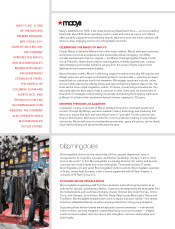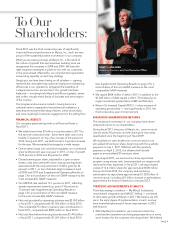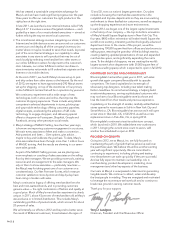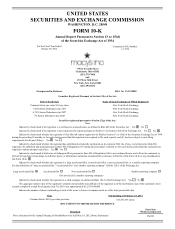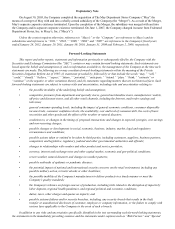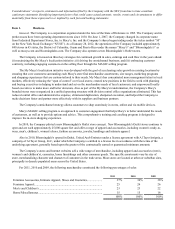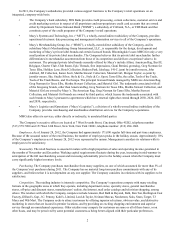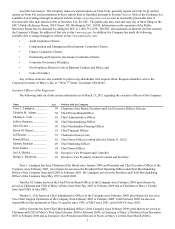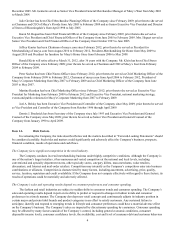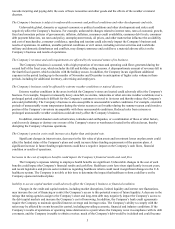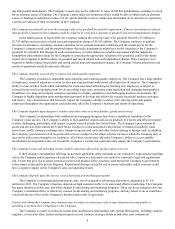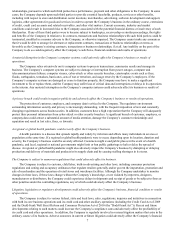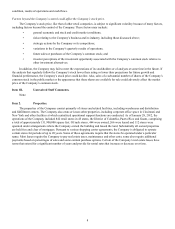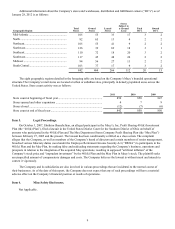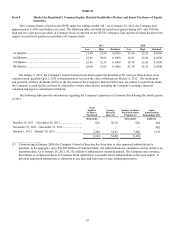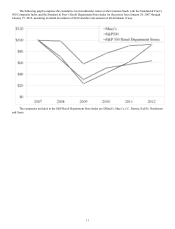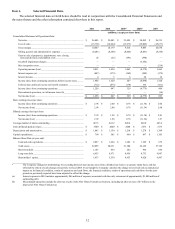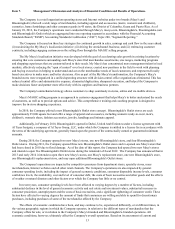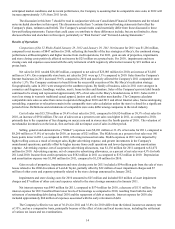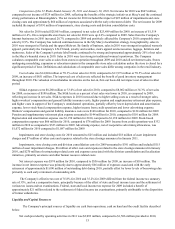Macy's 2011 Annual Report Download - page 11
Download and view the complete annual report
Please find page 11 of the 2011 Macy's annual report below. You can navigate through the pages in the report by either clicking on the pages listed below, or by using the keyword search tool below to find specific information within the annual report.5
towards incurring and paying debt, the costs of basic necessities and other goods and the effects of the weather or natural
disasters.
The Company’s business is subject to unfavorable economic and political conditions and other developments and risks.
Unfavorable global, domestic or regional economic or political conditions and other developments and risks could
negatively affect the Company’s business. For example, unfavorable changes related to interest rates, rates of economic growth,
fiscal and monetary policies of governments, inflation, deflation, consumer credit availability, consumer debt levels, consumer
debt payment behaviors, tax rates and policy, unemployment trends, oil prices, and other matters that influence the availability
and cost of merchandise, consumer confidence, spending and tourism could adversely impact the Company’s business and
results of operations. In addition, unstable political conditions or civil unrest, including terrorist activities and worldwide
military and domestic disturbances and conflicts, may disrupt commerce and could have a material adverse effect on the
Company’s business and results of operations.
The Company’s revenues and cash requirements are affected by the seasonal nature of its business.
The Company’s business is seasonal, with a high proportion of revenues and operating cash flows generated during the
second half of the fiscal year, which includes the fall and holiday selling seasons. A disproportionate amount of revenues fall in
the fourth fiscal quarter, which coincides with the holiday season. In addition, the Company incurs significant additional
expenses in the period leading up to the months of November and December in anticipation of higher sales volume in those
periods, including for additional inventory, advertising and employees.
The Company’s business could be affected by extreme weather conditions or natural disasters.
Extreme weather conditions in the areas in which the Company’s stores are located could adversely affect the Company’s
business. For example, frequent or unusually heavy snowfall, ice storms, rainstorms or other extreme weather conditions over a
prolonged period could make it difficult for the Company’s customers to travel to its stores and thereby reduce the Company’s
sales and profitability. The Company’s business is also susceptible to unseasonable weather conditions. For example, extended
periods of unseasonably warm temperatures during the winter season or cool weather during the summer season could render a
portion of the Company’s inventory incompatible with those unseasonable conditions. Reduced sales from extreme or
prolonged unseasonable weather conditions could adversely affect the Company’s business.
In addition, natural disasters such as hurricanes, tornadoes and earthquakes, or a combination of these or other factors,
could severely damage or destroy one or more of the Company’s stores or warehouses located in the affected areas, thereby
disrupting the Company’s business operations.
The Company’s pension costs could increase at a higher than anticipated rate.
Significant changes in interest rates, decreases in the fair value of plan assets and investment losses on plan assets could
affect the funded status of the Company’s plans and could increase future funding requirements of the pension plans. A
significant increase in future funding requirements could have a negative impact on the Company’s cash flows, financial
condition or results of operations.
Increases in the cost of employee benefits could impact the Company’s financial results and cash flow.
The Company’s expenses relating to employee health benefits are significant. Unfavorable changes in the cost of such
benefits could impact the Company’s financial results and cash flow. Healthcare costs have risen significantly in recent years,
and recent legislative and private sector initiatives regarding healthcare reform could result in significant changes to the U.S.
healthcare system. The Company is not able at this time to determine the impact that healthcare reform could have on the
Company-sponsored medical plans.
Inability to access capital markets could adversely affect the Company’s business or financial condition.
Changes in the credit and capital markets, including market disruptions, limited liquidity and interest rate fluctuations,
may increase the cost of financing or restrict the Company’s access to this potential source of future liquidity. A decrease in the
ratings that rating agencies assign to the Company’s short and long-term debt may negatively impact the Company’s access to
the debt capital markets and increase the Company’s cost of borrowing. In addition, the Company’s bank credit agreements
require the Company to maintain specified interest coverage and leverage ratios. The Company’s ability to comply with the
ratios may be affected by events beyond its control, including prevailing economic, financial and industry conditions. If the
Company’s results of operations or operating ratios deteriorate to a point where the Company is not in compliance with its debt
covenants, and the Company is unable to obtain a waiver, much of the Company’s debt would be in default and could become


